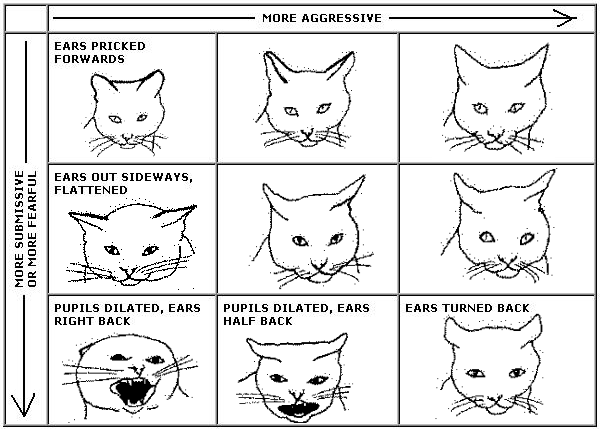Dogs and cats rely heavily on nonverbal signals to communicate their moods. Their facial expressions, ear position, tail position and movement, and overall body stance convey their intentions. Ideally, we take all of these components into consideration because the same detail can convey different meanings when other details are also considered. For example, dogs wag their tails when they’re feeling aggressive and also when they’re feeling friendly; cats purr to indicate that they’re nervous and also to tell us that they’re content.

So many tails, so little time. (I’d give these dogs more room than this. Especially the poor little dog in the center!) (Photo courtesy of Oskarp.)
Ear and tail position and movement are the details that are usually easiest to observe from a safe distance, often providing the most information about mood. Of course these descriptions apply to animals who have full mobility of their bodies. Keep in mind that some types of tails are more expressive than others; a black lab’s long, straight tail has moves differently than a pug’s shorter, curly tail.
Common signs of happy, friendly dogs:
- Relaxed face, possibly panting slowly
- Corners of the mouth slightly turned up (smiling)
- Relaxed body position
- Tail wagging from side-to-side or in a circular motion
- When standing: in neutral, happy stance (relaxed with weight evenly balanced on all feet) or play bow stance (front end down and rear end up)
- When sitting or lying down: one paw folded and tucked under

Common signs of happy, friendly cats:
- Eyes half-closed, pupils narrowed, blinking leisurely
- Ears slightly to the side and slightly forward
- Tail mostly still
- When standing: tail straight up or curled forward at tip and possibly twitching side-to-side
- Paws kneading
- Purring
Below are some of my favorite websites with illustrations of dog and cat body language.
Jay Padilla includes these images of dog body language “Signals” on Tuscon Grooming Pets & Grooming Services website (http://www.tucsongrooming.com/?p=23):
Sarah Hartwell’s web page “Cat Communication – Body Language” (http://messybeast.com/cat_talk2.htm) includes this graphic showing facial expressions and ear positions of cats:
Catster’s “Cat Body Language” article (http://www.catster.com/cat-behavior/cat-body-language) has these great images of cat tail positions and what they mean:
 If this article is helpful & you’re able, please consider sending a thank-you tip/donation. Even small donations will help me keep my business running during the travel industry slump that has brought pet sitting to a screeching halt. Thank you! (FYI, for a sliding scale fee starting at $30, I offer consultations to help people solve their specific cat-related issues. Let me know what I can help you with.)
If this article is helpful & you’re able, please consider sending a thank-you tip/donation. Even small donations will help me keep my business running during the travel industry slump that has brought pet sitting to a screeching halt. Thank you! (FYI, for a sliding scale fee starting at $30, I offer consultations to help people solve their specific cat-related issues. Let me know what I can help you with.)
(Note: Nonexclusive use of this article has been granted to other pet industry organizations but Kari Kells retains copyright.)
Select sources
- American Society for the Prevention of Cruelty to Animals (ASPCA). “Canine body language“. Virtual pet behaviorist. 4 Feb 2014. http://www.aspca.org/pet-care/virtual-pet-behaviorist/dog-behavior/canine-body-language
- Bishko, Adriane. “What your cat’s body language is saying“. WebMD healthy cats feature stories. 21 Apr 2012. 4 Feb 2014. http://pets.webmd.com/cats/features/cat-body-language
- Catster. “Cat body language”. Cat behavior and training. 18 Nov 2012. http://www.catster.com/cat-behavior/cat-body-language
-
Coren, Stanley. “How to read your dog’s body language“. Modern Dog. 4 Feb 2014. http://moderndogmagazine.com/articles/how-read-your-dogs-body-language/415
- Dibra, Bashkim. “How to interpret your dog’s body language, facial expressions and vocalizations“. Paws across America. 4 Feb 2014. http://www.pawsacrossamerica.com/interpret.html
- Hartwell, Sarah. “Cat communication – body language”. Messybeast portal. 18 Nov 2012. http://messybeast.com/cat_talk2.htm
- Human Society of the United States. “Cat chat: Understanding feline language”. 15 May 2013. 4 Feb 2014. http://www.humanesociety.org/animals/cats/tips/cat_communication.html
- Tuscon Grooming Pets & Grooming Services. 18 Nov 2012. http://www.tucsongrooming.com/?p=23.





A precise & well-wrtitten post. Thanks heaps for sharing it.
An abbreviated version of this was just posted as a guest blog post on the ASPCA pet health insurance blog at http://www.aspcapetinsurance.com/pet-insurance-blog/post/How-to-Read-Your-Pete28099s-Body-Language.aspx